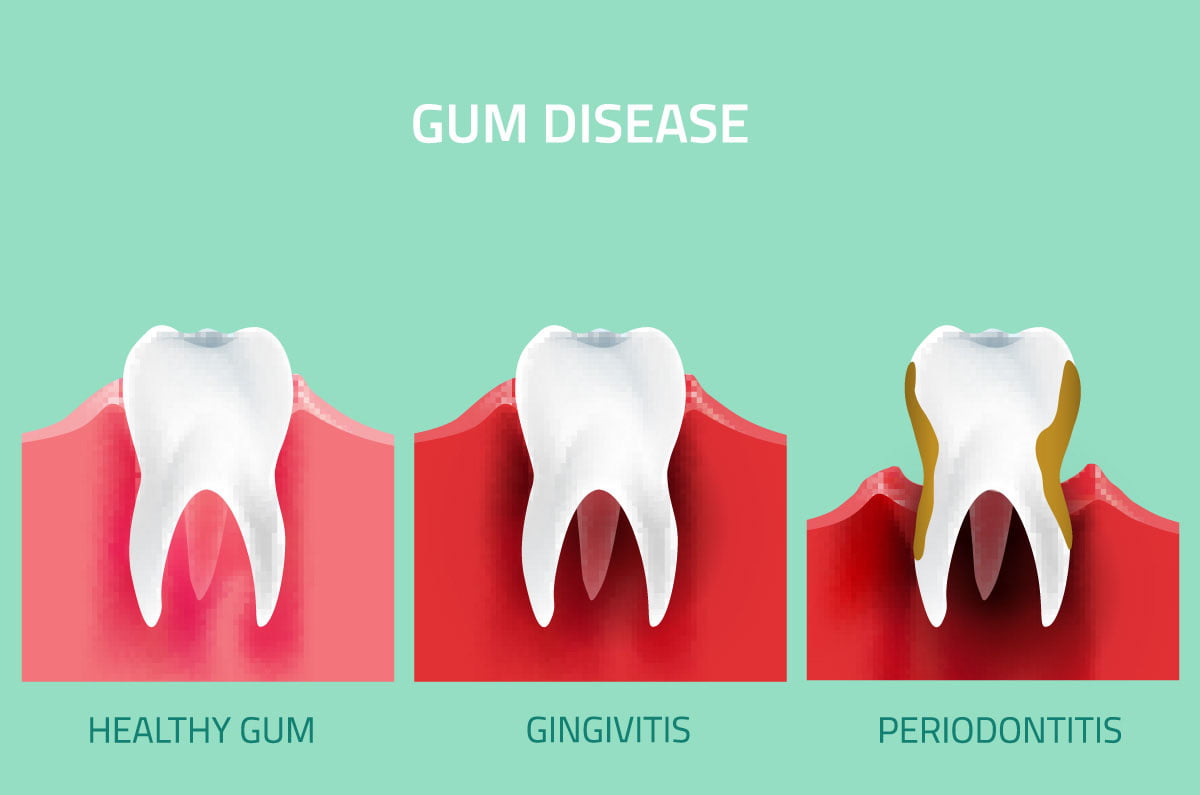
Gingivitis (inflamed and bleeding gums) is a common problem due to non- hygienic situations of unsufficient teeth cleaning and brushing.
Classical signs of gingivitis :
- Swelling of the gums
- The gums look red (instead of having a pink color).
Please, observe that a smoker with severe gingivitis, will show all the classical signs of inflammation with one exception, the gums will still look pale; none or very little inflammation (redness) of the gums will be seen. - The gums bleed when you brush your teeth. In severe cases, even chewing of food might cause bleeding from the gums.
- Pain or discomfort from the gums, especially when brushing.
The most common cause of gingivitis is poor oral hygiene. Good oral hygien such as daily brushing (at least morning & evening) and flossing (at least once a day; preferably at night, after the brushing), prevents gingivitis.
In the absence of treatment, gingivitis may progress to periodontitis (periodontal disease), where bacteria break down the bone, which support the teeth. For optimal oral health, a team approach is required, involving the dentist but even more so the patient.
Periodontitis (gum disease)
Left untreated, gingivitis can progress to periodontitis (gum disease), which by its nature is destructive to the bone around the teeth, thereby, loosening the teeth. In severe cases, teeth can actually fall out, as there is no bone left holding them.
Gum disease (periodontal disease) is the major cause for losing teeth in adults. Typical symptoms of periodontal disease are:
- Dark red gums
- Bleeding of the gums
- Soreness in the gums
- Swelling of the gums
- Pus around teeth
- Spaces appearing between teeth
- Receding gums
- Persistent bad breath
- Sore teeth when chewing
It is also possible to have gum disease with no symptoms, which can be identified with the X-rays.
Scaling & Polishing
This is a special cleaning of your teeth, which removes calculus (tartar) and stains.
At your scale and polish appointment, our dentist will make a careful assessment of the condition of your gums. Your teeth will then be scaled, using an ultrasonic scaler which removes the calculus and the stains from your teeth. The teeth are then polished, leaving them clean and smooth. This makes it easier for you to keep them clean at home.
It is important to see your dentist regularly for scaling and polishing but also that you brush and floss your teeth carefully every day.
If your gums are inflamed, swollen and bleed when you brush your teeth and maybe even when you eat, you most likely have gingivitis (inflammation of the gums) that is mainly caused by inadequate oral hygiene. Maybe you do not spend enough time brushing your teeth, or you do not brush them properly. Perhaps you do not floss your teeth properly or even floss them at all.
Dental plaque is a sticky, whitish substance made up of bacteria and food debris, which is built up on your teeth and the gum margin. The different bacteria in the dental plaque release toxins which irritate the gingiva (gums). The longer dental plaque is left on the teeth, the harder it becomes, due to continuous accumulation of minerals from the saliva into the dental plaque. Already after 24 hours, some dental plaque will be hardened into calculus (tartar). You cannot remove tartar just by brushing or flossing your teeth, but a dentist or dental hygienist can remove it. This procedure is called scaling. The scaling and polishing removes calculus and stains from for example, coffee, tea, cigarettes or red wine and it makes it more difficult for plaque to stick to your teeth again, as the teeth are all smooth afterwards.
Ultrasonic scaler
An ultrasonic scaler is an electronic instrument which transmits high-frequency vibrations (from 25,000 to 40,000 cycles per second) to a small metallic tip inserted into a hand piece. With this instrument hard deposits (calculus) can easily be removed from the surface of a tooth.

